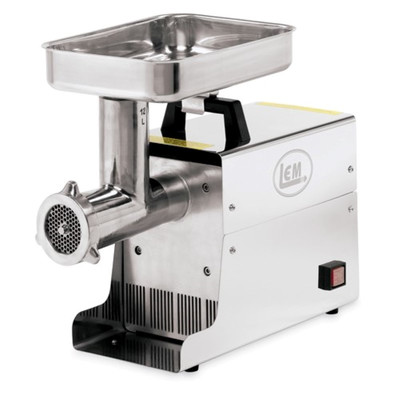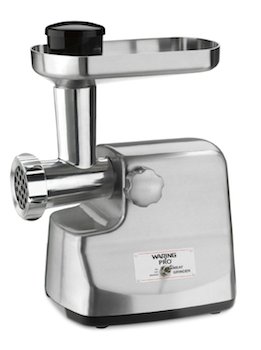Because meat keeps far longer in the freezer than in the fridge, knowing how to safely thaw meat is an essential part of every cook’s skillset. Certain methods, such as leaving an exposed package of chicken breast on the counter for hours, can breed bacteria and cause illness. You can choose to thaw animal products in the refrigerator, under cold water, or in the microwave.
Thawing in the Fridge
The safest way to defrost meat–putting it in the refrigerator–requires planning ahead, because it takes 24 hours for every 5 pounds of meat to thaw all the way. Even small amounts of frozen food, such as a pound of ground meat or boneless chicken breasts, require a full day to thaw. However, this method is also the simplest because it only requires a refrigerator. To thaw meat in the fridge, place it on a plate either in its original plastic packaging or covered with plastic wrap. The plate keeps any moisture released from the thawing process from leaking all over your fridge. Remember that some areas of the fridge may keep food colder than other areas (in most fridges, that area is the bottom). Food will also take longer to thaw in a refrigerator set at 35°F than one set at 40°F.
Since the meat will already be refrigerated, you won’t have to worry about cooking the meat immediately after it finishes thawing. Thawed poultry, fish, or ground meat can be kept there for an additional 1 to 2 days before cooking. Beef, pork, lamb, or veal (roasts, steaks or chops) last a little longer; you can keep those in the fridge for another 3 to 5 days after thawing. Always defrost large pieces of meat using this method, since the quicker methods listed below are more effective with smaller portions. If you eventually decide not to cook the meat you just thawed, you can safely refreeze it within the same time limits, although there may be some loss of quality.
Thawing Under Cold Water
You don’t always have the time to spend defrosting meat in the fridge. If you just decided to cook some frozen shrimp 5 minutes ago, you can easily thaw them by placing them in a resealable plastic bag and submerging them under cold water. Some people will recommend hot water, but you run the risk of heating the meat so it reaches the temperature “danger zone” (anywhere between 40°F and 140°F), which is the range where bacteria is much more likely to multiply quickly. The plastic bag keeps the meat from absorbing the water.
Alternatively, you can put the meat in a colander and run some cold water over the top, which is easier for small chunks of meat like shrimp that can get stuck together. Use your hands to gently break the frozen meat apart under the running water. Keep in mind that the meat may absorb some water if you use this method. For either of these cold water methods, make sure to cook the meat through before putting it back in the fridge or refreezing.
Thawing in the Microwave
This is the fastest method of thawing meat, but you must cook the meat immediately after you thaw it. Thawing meat in the microwave can partially cook or warm the meat, bringing it into the temperature danger zone mentioned above. Do not store it for later cooking. To thaw meat in the microwave, first remove all packaging and place the meat on a microwave-safe plate. Then defrost the meat on low or use the thaw setting on the microwave. A larger piece of meat will take longer to thaw (usually thaw settings require you to enter the number of pounds the meat weighs).
This method averages only 5 to 10 minutes, but you have to keep an eye on the microwave. If you cook the food for too long, you’ll risk semi-cooking the meat, which can make it tough and stringy. Keep checking on the progress of the food and remove it once it’s done defrosting. For best results, place thinner portions of meat in the center of the microwave, where they’re less likely to overcook. As with the cold water method, you should always fully cook meat defrosted in the microwave before refrigerating or refreezing it.
Cooking Frozen Foods
When you don’t want to spend time thawing frozen foods, remember that you can safely cook frozen food. However, they may release some water when you cook them, which could affect the consistency of any sauces. The cooking process will take about 50% longer than the recommended time for fully thawed or fresh meat and poultry. Be careful to check the progress of the meat periodically so you don’t undercook it.
Defrosting Turkey
While defrosting a few steaks or some fish fillets is pretty simple, many people struggle with how to defrost a large turkey for Thanksgiving Day or other holidays. As with all other animal products, never defrost a turkey by leaving it out on the counter for a couple hours or you risk breeding bacteria. You can also use the three methods listed above, but you should only try microwaving your turkey if it’s really small and you’re pressed for time. Thawing your turkey in the refrigerator overnight is still your best bet; just remember to allow 24 hours for every 5 pounds of turkey. That means a 15-pound turkey would need to defrost over the course of 3 days.
So next time you’re planning to cook some meat that has been sitting in your freezer for weeks, break out these tips so you can thaw your meat safely and preserve its quality.


